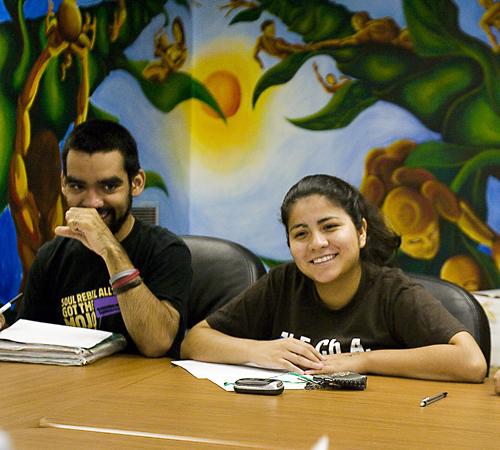La Casa nears milestone

From left, Jaime Cornejo and Cindy San Miguel, seniors in LAS, and Cecilia Macias, junior in LAS, share programming ideas at La Casa Cultural Latina. Erica Magda
September 20, 2007
Editor’s note: The following is third in a series of stories profiling the cultural houses on campus.
As La Casa Cultural Latina is approaching its 35th anniversary in the forthcoming years, the faculty of the center is planning on making evolutionary changes.
Part of these evolutionary changes involve La Casa’s mission statement, which is to provide a space for programs that will lead to higher recruitment and retention rates as well as improving the advancement and empowerment of Latina/o students, said Adele Lozano, director of the center.
La Casa, located at 1203 W. Nevada St., opened its doors to the student community in 1974 on Chalmers Street. As a result of student protests and activism, a Latina/o studies program was established and the new La Casa site on Nevada Street soon followed, Lozano said.
“I think the University has not set a positive relationship with Latina/o students,” said Cindy San Miguel, senior in LAS and staff member of the center. “We had to fight for La Casa. It’s not like the resources we have now were handed to us.”
Get The Daily Illini in your inbox!
Since the beginning of the cultural center’s existence on campus, it has often been referred to as “a home away from home,” Lozano said. However, she said her goal is to evolve the center to serve a much broader purpose.
“There’s a great need for (cultural centers), especially on a predominantly white campus,” Lozano said. “It’s necessary, but now in the 21st century, we have to be a safe haven and more.”
Aside from being a safe haven for Latina/o students, Lozano’s goals for La Casa are to focus on Latina/o student retention rates as well as becoming more visible to the rest of campus.
“What can easily happen with cultural centers is that they can be marginalized,” Lozano said. “They can be there, but the general student population many not necessarily know they’re there.”
La Casa offers many programs and workshops to promote and learn about cultural diversity, said Christina Rodriguez, graduate in Communications.
META, the main retention program held at La Casa, is an acronym for Mentoring Encouraging Teaching Achieving and is also a Spanish word meaning ‘goal.’
The program’s objective is to help students set realistic, attainable goals periodically throughout the semester and formulate a plan of action, San Miguel said.
Despite the myriad of resources provided at La Casa, many students have not taken advantage of them, said Jose Ramos, senior in FAA and programmer and night monitor at the center.
Ramos said he would like to see more students attend events that take place at La Casa.
La Casa should not be labeled as only for those interested in Latina/o studies because there are many aspects to the center, said Jonathan Contreras, sophomore in LAS and president of the Mexican Student Association. There are opportunities for students to become involved in activities ranging from art to politics, he added.
“I want to give the impression that La Casa is not just for Latina/o or underrepresented students,” Rodriguez said. “It’s a place for everybody.”






